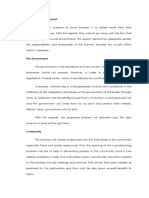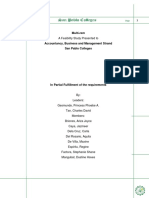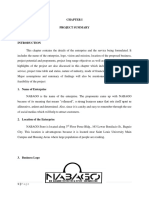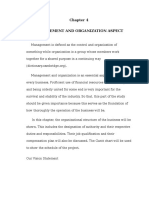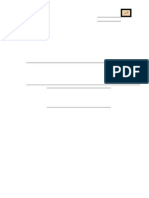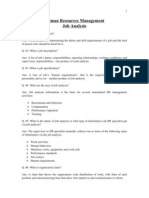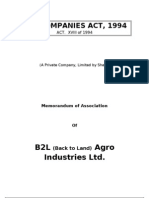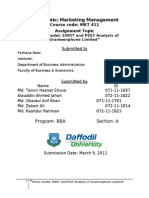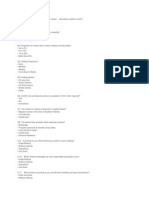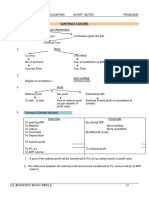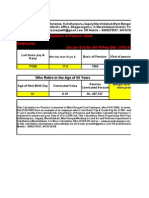Feasibility Study of Student Loan
Feasibility Study of Student Loan
Uploaded by
Alauddin Ahmed JahanCopyright:
Available Formats
Feasibility Study of Student Loan
Feasibility Study of Student Loan
Uploaded by
Alauddin Ahmed JahanOriginal Description:
Copyright
Available Formats
Share this document
Did you find this document useful?
Is this content inappropriate?
Copyright:
Available Formats
Feasibility Study of Student Loan
Feasibility Study of Student Loan
Uploaded by
Alauddin Ahmed JahanCopyright:
Available Formats
FEASIBILITY STUDY OF STUDENT LOAN FOR BANK ASIA
Course Name : Social Research Methodology Course No. : 306
Submitted By : Sharmen Saife Sharmin Hanif Mousumi Goswami Halima Akhter Kamrun Naher Sheikh Humaira : : : : : : 58 (RK) 65 (RK) 69 (RK) 70 (RK) 78 (RK) 80 (SN)
Department of Statistics, Bio-Statistics & Informatics University of Dhaka
1
The introduction of retail banking in Bangladesh has led the banking industry to the doorstep of embryonic prospects and potentials. Consequently numerous local and foreign banks came as being in this country to avail the ample of opportunities for their financial betterment. In recent years, the banks are aggressively pursuing their marketing strategy to grab new segments with intent to explore new opportunities. Ignited by the strategic intent, innovation of new products and service exhibited remarkable increase. ATM, credit card, debit card, online banking, Mbanking, personalize loans etc. are some of the outcomes of this continuous innovation and improvement. However, not all the opportunities have been availed yet. Still there are numerous opportunities are present and some more to emerge. It needs continuous improvement and customer orientation to be able to avail those opportunities to a wide extent.
Background of the study:
Recent decades have witnessed not only fierce competition but also a wider degree of customer orientation in service industries, especially in banking sector in Bangladesh. Besides the local banks the foreign banks are continuously competing for the opportunities prevalent in the market. The profit-making urge fueled by the ample of opportunities has intensified the rivalry among the banks and so as
the degree of persuasion of customer orientation. Innovation on new products and services resulted in as a consequence of this competition.
Even if Bank Asia Limited is not confronting extreme difficulties, yet it is lagging behind to some extent to its major competitors. Competitors like Standard Chartered or HSBC through their service innovation; have placed themselves in advantageous position .At the same time this put pressure on their counterparts to engage in a battle of innovation and to involve in a continuous effort to come up with products and services that better fit the customers need. BANK ASIA Started to provide their service in Bangladesh in 27th Nov year 1999. Bank Asia has been launched by a group of successful entrepreneurs with recognized standing in the society. The paid up capital of the Bank is 1116 million. The management of the Bank consists of a team led by senior bankers with decades of experience in national and international markets. The senior management team is ably supported by a group of professionals many of whom have exposure in the international market. Within a short span of time Bank Asia has established itself as one of the fast growing local private banks. It has at present a network of Twenty-three branches serving many of the leading corporate houses and is gradually moving towards retail banking.
Growth of the Bank :
The asset and liability growth has been remarkable. By Dec 2007 the total asset of the Bank grew to Tk 30,478 million, increase of almost 30% comparing to 2006. As of Dec 2007 deposits increased to Tk 25,289 million, an
increase of 37% over that of 2006, and Loans & Advances reached Tk 22,256 million, an increase of 25% over that of 2005. Bank Asia has been actively participating in the local money market as well as foreign currency market without exposing the Bank to vulnerable positions.
Mission Statement
To assist in bringing high quality service to our customers and to participate in the growth and expansion of our national economy.
Vision statement :
Bank Asias vision is to have poverty free Bangladesh in course of a generation in the new millennium, reflecting the national dream. Our vision is to build a society where human dignity and human rights receive the highest consideration along with reduction of poverty.
Products and services:
Gradually Bank Asia increases its product list. Every year Bank launches 2 products. Since establish, Banks product list is so healthy and includes most features. Whenever, Bank launch a product, they look deeply in its technical issue. Its mean, how the product will be techno based and support online features.
Products and services Include:
SMS Banking Through SMS facility you can access your account using your mobile phone scenario from anywhere, anytime at your convenience to know the account position.
Customized Loan Modern Banking is a result of evolutions driven by changing economic activities and lifestyles. Bank Asia Ltd. is a new entrant in the private banking of Bangladesh. It is an immense pleasure for Bank Asia to introduce Customized Loan to its customers as a unique Loans plan. Internet Banking Bank Asia symbolizes modern banking with innovative services in Bangladesh. It has centralized Database with online ATM, SMS and Internet query service. You can use credit/debit card facility with ATM. For SMS service you should have personal cellular phone with at least one account in Bank Asia.
Bonus Savings Schemes Bank Asia Ltd. promise to fulfill every possible customer need with high efficiency and satisfaction. Its team of dedicated professionals is committed to provide an unparalleled service by using the latest technology to make bankable proposals harvest maximum benefits for the customers, the shareholders the society at large. It is an immense pleasure for Bank Asia to introduce Bonus Savings to its customers. Mobile Banking M-Banking allows customers to access their bank accounts from their Mobile Phone. This latest technology driven product is designed to cater for and facilitate real time banking transactions using a mobile phone currently available to AKTEL subscribers only. Poverty Alleviation Bangladesh is a highly populated developing nation, where 80% of the people living in the rural areas. But these people cant engage themselves with 5
development and production activities due to unavailability of capital. Bank Asia highly dedicated to establish rural branches to empower the poor people.
Objectives of the Scheme:
To help people by providing loan facilities to establish fisheries plant, Poultry firm, small and cottage industry, village transport and small engineering workshop as well as to establish computer-training center where electricity supply is available. It will help to create employment opportunities for the unemployed young people. Through the research I tried to introduce a service that possibly can be provided by Bank Asia to some degree of competitive edge over its counterparts. Student loan, a relatively new concept in Bangladesh even if is widely practiced in Europe and the west part of the world. The wide spread of education industry in Bangladesh and the obvious need for human resource development propelled the potential for the student loan in our country context. Considering the potential, I was aspired to conduct a feasibility study of student loan in Dhaka, with special reference to Bank Asia Limited.
Statement of the problem:
The need for human resource development with attention to quality, relevance and timeliness led to the establishment of non government universities in Bangladesh very recently. Despite of difference in the tuition fees among universities, mostly these universities are very expensive. Except for the affluent class it becomes burdensome for most of the middle-income group to put up with the educational expenses.
Even though there is a provision of financial assistantship in most of the private universities but the range is not adequate enough and not all the students are eligible to grab this opportunity. Thus there is a need for supporting meritorious students financially through loans & grant. There are also students who are willing to study abroad but cannot afford to pay the whole tuition fees at a time. In addition to this three are also professionals who are undergoing different professional courses like MBA, CMA, CA, MSC, PHD etc in different educational institutions. Sometimes serving the family and finance their own educational expenses simultaneously become troublesome from their part. These students are also a potential market of the student loan for the financial institutions. The focus of the entire research will be to explore the prospects & the probable risk associated with the student loan scheme.
Literature Review:
Haq Muhammad Ziaul & Barua Abhijit in their article Student Loan Scheme for Higher Education in Non-Government University of Bangladesh: Risk and Prospects. This paper has developed a detailed proposal for partial financial assistance from commercial banks for meritorious but needy students pursuing professional degree, diploma and certificate courses in Nongovernment University. Through the research the authors came up with a bold proposal worthy of consideration for the human resource development and social transformation in Bangladesh to promote education on the basis of merit rather than on ability to finance. The proposal is outlined as more like a social responsibility of banks
towards the society with minimal profit. The transaction process will be between the institution and the bank on account of the needy students. According to the proposal of the researchers, the loan will cover only partial
tuition cost (20% -80%), with an average of 50% .The loan will be created on semester basis and is to be directly paid to the institution. The loan will bear an interest rate of 1% or 2% above the central banks borrowing rate. A 3% additional charge will be made to create a risk coverage fund. Loan period will be same as study period and an additional 6 months for employment income generation. The students shall be primarily liable for the loan and shall produce a guarantor to ensure some degree of assurance .The recovery of funds for failure cases can be maximized with the introduction of a fund to cover bad debts and also to buy an insurance policy if available for bad debts. Although the contribution of this loan scheme to the profit of bank is very low, bank might be interested in this offer as a part of their social commitment towards the development of the country in the long run, develop some of its existing, manpower and future executives with minimal cost and risks and lower risk of default. Finally, the authors believe that the proposal is bold, innovative and worthy of consideration for the human resource development and social transformation in Bangladesh to promote education on the basis of merit rather than on ability to finance.
Williams John in his article Student Loans: An effective Instrument For Cost Recovery In Higher Education has introduced the audience to different kinds of student loan schemes offered by either government or by the commercial banks in United States of America to the US or other foreign students to finance their study. The article also encompasses the procedure and the types of alternatives to be pursued to overcome the unpleasant consequences. In this article the author has described two types of student loans - federal loans & private loans. The federal loan is granted to the students if they have any permanent source of income and a good credit history, the Federal Parent Loans for Undergraduate Students (PLUS) loans are granted to creditworthy
parents of undergraduate students and
can be used to cover up to the total cost of your education. Private loans offered by the commercial banks and there are no limits as to what the interest rate will be for a private loan. So a student who signs up for a private student loan at six percent can end up paying as much as 19 percent after they graduate. Private student loans can also check up on a student's credit history and charge more if a student has poor credit records or no history at all. An exhausting list of papers regarding the financial information, contact information, credit history, present and past occupations and employer information, proof of enrollment, proof of citizenship or permanent resident status and so on will be needed to apply for the loan. The extent of the documentation will leave no aspect of ones life private. Failure to repay the loans on time or according to the terms of condition undertaken, will affect credit rating and this default may even ended up with legal proceedings. However, to avoid the disputes the applicants can talk to their financial advisors in the institution and can obtain flexible payment terms with enhanced time period and affordable interest rate. Recently in Bangladesh some of the private banks are providing student loan, but the extent of the aid is not sufficient enough to support the rising demand. In the research an effort has been made to explore the prospects and problems of student loan for in Dhaka for Bank Asia
Objectives of the study:
The objective of the research is Feasibility Study of Student Loan For Bank Asia. 1. To explore the prospects for student loan in Dhaka city.
2. To identify the problems of student loan in Dhaka city. 3. To prepare a model loan scheme for Bank Asia.
Hypothesis:
Hypothesis:1 Null Hypothesis: H0: Bank Asia should not provide unsecured loan Alternative Hypothesis: H1: bank Asia should provide unsecured loan Hypothesis:2 Null Hypothesis: H0: Higher recovery rate is not the indicator of the prevalence of the feasibility of the study loan. Alternative Hypothesis: H1: Higher recovery rate is the indicator of the prevalence of the feasibility of the study loan. Hypothesis:3 Null Hypothesis: H0: Bank Asia should not introduce student loan scheme to Compete with HSBC & SCB. Alternative Hypothesis: H1: Bank Asia should introduce student loan scheme to compete With HSBC & SCB. Hypothesis:4 Null Hypothesis: H0:: Less interest rate is not appealing to the consumers Alternative Hypothesis: H1: Less interest rate is appealing to the consumers. Hypothesis:5 Null Hypothesis: H0: Better loan system with competitive interest rate can not meet the needs of both students & Bank. Alternative Hypothesis: H1: Better loan system with competitive interest rate can meet the needs of both students & Bank. 10
Hypothesis:6 Null Hypothesis: H0:: Other Banks are not competitive & not doing well in this regard. Alternative Hypothesis: H1: Other Banks are doing well & competitive in this regard. Hypothesis:7 Null Hypothesis: H0:: Bank cant earn profit without initializing student loan Alternative Hypothesis: H1: Bank can earn profit without initializing student loan. Hypothesis:8 Null Hypothesis: H0:: Student loan can not bring differentiation among Banks. Alternative Hypothesis: H1: Student loan can bring differentiation among Banks. Hypothesis:9 Null Hypothesis: H0:: Student loan scheme can bring neither goodwill nor attention of prospective consumers like students. Alternative Hypothesis: H1: Student loan scheme can bring both goodwill & grab attention of prospective customers like students.
Sampling Design:
For sampling Non-probability sampling should pursued. Two types of Non Probabilistic Sampling should be used in this research 1. Judgmental sampling 2. Snowball Sampling. At first for selecting students, by using Judgmental sampling a sample of 150 students will be taken.. Then 30 students from Independent university Bangladesh, 30 from Premier University, & 30 students from Brac University should be interviewed. Also 30 professional students will select from these
11
universities, 10 professional students from each university. In addition, 30 students who are preparing for studying abroad also been interviewed and snowball sampling will be used in this regard. In a nutshell to ensure the representation of different types of students in the sample 90-fulltime students, 30 professional students and 30 students who are willing to study abroad will be in the sample. For selecting banks judgmental sampling have been used and 3 banks HSBC, SCB, EBL have been selected.
Methodology:
Sampling plan: 1. Population : (a) Population of students: All the students & professionals who need financial assistance to support their study either in this country or in abroad (b) Population of bank: All the commercial banks in Dhaka city.
2. Sample Unit (a) Sample Unit for students: The students (fulltime & professional students) of 3 leading private universities Independent university Bangladesh, Premier University, Brac Universities will be the respondents of the research. These 3 universities will be considered as the sample unit for students. (b)Sample Unit for banks: The executives of the banks that have the student loan scheme have been 12
interviewed. The sample unit for the banks is the branches (Dhanmondi) of HSBC, Standard Chartered and Eastern Bank Limited of Dhaka
Methods of data collection:
The report will be completed by both primary and secondary sources of data. Primary Data: Primary data will be collected by using the following two tools. 1. Questionnaire Method. 2. Direct Interview Method. Primary data will be collected by informal interview with the students of the educational institutions. Some information will be collected through discussion with different executives of the Banks. Also Data have been collected through questionnaire from the students of private universities as well as the executives of the selected banks .Two separate structured questionnaires have been used to collect information from the students and the bank personnel. Secondary Data: The secondary data will collected from the Credit Manual brochure published by other banks and from some journals. Also some important information will collected form Internet for the analysis.
Method for Analysis:
13
In order to analyze and interpret
data some tools of statistical analysis have
been used .The statistical tools to be followed are 1. Mean. 2. Percentage. 3. Cross tabulation 4. Median 5. Standard deviation 6. Standard error.
Time schedule:
Our six month work plan is given below by GANTT CHART. Month Activities 1. Preparatory activities 2. Recruitment, training & pre-testing 3. Data collection 4. Data editing, coding & entry 5. Data analysis 6. Preliminary reports & dissemination 7. Final report
July Augu st Septembe r October November December
Financial Budgeting:
Expenses A. 1 2 Materials, supplies & computer services Questionnaire printing Editing & typing
Local Taka 500 500
14
3 4 B. 1 2 C. D.
Computer programming Report Printing & mailing Sub-total Travel Pre-testing of questionnaire conveyance Sub-total Dissemination Seminar Miscellaneous expenses Total funding required(A+B+C+D)
500 1000 2500 500 3000 3500 2000 2000 10000
Summary of the Study:
There is a strong demand of student loan in the market. The demand is stronger among the middleincome and the lower middle-income group of the market, who are ready to pay high interest rate. Usually the high-income group is safer than the middle-income group but this middle-income group is more lucrative in terms of profit potential. banks. Although student loan is risky it will be highly profitable In recent years, both the foreign and local banks are aggressively pursuing their marketing strategy to grab new segments with intent to explore new opportunities. Introduction of student loan will not only bring high profit potential but also it will provide Bank Asia a competitive edge over its major competitors. Besides strengthening the competitive position in the long run the introduction of student loan will contribute to a wide extent to the human resource and socio economic development of Bangladesh, which will in tern enhance the brand image of Bank Asia in the consumers mind.
15
4.0 Findings and Analysis Awareness regarding Student Loan: Frequency 129 21 Percentage 87% 14%
Aware Unaware
Most of the students are already educated about the idea of student loan. So it will be easier for Bank Asia to create awareness if they lunch the student loan since the market is already aware about the product.
he probable consequences in case of defaults Willingness of students to take student loan:
16
Willing Unwilling
Frequency 145 5
Percentage 97% 3%
There is a prevalence of a high level of willingness among the students to take student loan, which may be an indicator of the level of existing demand. Relationship between income level and customers expected interest rate: Interest rate Income 50000+ 41000-50000 31000-40000 21000-30000 10000-20000 5% - 8% 40% 42% 3.6% 3% 60% 9% - 12% 26.6% 36% 5.4% 9% 30.4% 13% - 16% 20% 16% 34.5% 36.5% 8.6% 17% - 20% 13.4% 6% 56.5% 51.5% 1%
Relationship between income and types of security: Means of Security Income Physical Asset Financial Asset Guarantors A/C Income Statement /Pay Slip
50000+ 41000-50000 31000-40000 21000-30000 10000-20000
33.3% 26.3% 3.6% 3% 4.3%
40% 36.8% 12.7% 12% 8.6%
13.3% 15.7% 30.9% 51.5% 47.8%
13.4% 21.2% 52.7% 33.5% 39%
By Analyzing both the charts it is found that, the upper income group that is safer in terms of their ability to repay the loan and is able to keep physical and financial assets as security are willing to pay very low interest rate for student 17
loan. Therefore serving this segment might not be profitable in the long run because once the loan is repaid the security will be withdrawn and a little interest will be left for the bank as profit. Interestingly, most of the middle-income group and a significant portion of lower middle-income group are more willing to pay an interest rate higher than that of the high-income group for student loan. Since these income groups find it difficult to manage a big amount of money to pay tuition fees at a time, they are even ready to pay a high interest rate for the loan. Therefore there is a strong demand for student loan in this segment. But serving these segment bear a major risk, since a lion portion of these income groups are only able to exhibit Guarantors A/C and parents Income Statement as their ability to repay the loan. Customers expectation regarding the security of the loan: Type of loan Secured Unsecured Frequency 40 105 Percentage 27.5% 72.5%
Majority of the consumers are asking for unsecured loan that has made the student loan offer little bit risky. Moreover the major competing banks HSBC and SCB are offering unsecured loan so it will be difficult for Bank Asia to sustain the competition unless they offer unsecured loan. But unsecured loan carry the risk of defaulting. Recovery rate of student loan of the banks: Banks HSBC Recovery rate 98% Average recovery rate
18
SCB EBL
97.5% 100%
In spite of having a little risk of defaulting, the average recovery rate of student loan of the existing banks is 98.5% .The high recovery rate indicates that a strong feasibility of student loan is prevalent in the market for the banks. Portion of the profit of banks contributed by student loan: Contribution to Bank HSBC SCB EBL profit 3.7% 4.2% 1.1% Average contribution to profit
All those 3 banks have enormous variety of products, student loan is just one of those many. Student loan is contributing on an average 3% of the total profit of the banks, which is really a considerable share of profit generated by one product out of many.
Abstract of analysis: The analysis revealed that there is a strong demand of student loan in the market. The demand is stronger among the middle-income and the lower middle-income group of the market, who are ready to pay high interest rate. Interestingly, the high end of the market is less enthusiastic about the loan and is willing to pay a little interest rate. Both the segment has pros and cons. In terms of security, the high-income group is safer than the middle-income group but this middle-income group is more lucrative in terms of profit potential . A little portion of the market is able to take secured loan while majority is asking for unsecured loan, making the loan subject to the risk of 19
recovery. However, the current recovery rate of the banks for student loan scheme is a significant 98.5%, which signals the enormous opportunity aligned with little recovery risk. Student loan is contributing 3% of the total profit to the banks, which indicates a high degree of profit potential for the banks. To conclude, although student loan is risky yet it might be highly profitable.
The third objective of the report is to develop a model student loan scheme. From the questionnaire survey and the brochures of HSBC, SCB and EBL detailed information about their student loan Scheme has been collected. Comparative features of student loan: HSBC 17% Unsecured 4 times of salary SCB 19% Unsecured EBL 13% Secured
Interest rate Loan type Terms
Minimum 18,000 TK salary requirement Maximum loan 750,000 TK amount Maximum loan 4 years period
Assessment of 90% of security bank statement N/A N/A 10,00,000 TK 4 years 90% of security 4 years
Reviewing the offerings of the competitors and considering the expectation of the students, the profit potentiality of the bank a model student loan scheme is proposed for Bank Asia. From the analysis it is revealed that there is a strong demand for unsecured loan and the major competing banks HSBC and SCB are offering unsecured
20
loan so it will be difficult for Bank Asia to sustain the competition unless they offer unsecured loan. However a reasonable portion (27.5%) of the consumers are able to keep security. Therefore bank Asia must offer unsecured loan and at the same time there also should be a secured loan scheme to grab the secured portion of the market. A model student loan scheme for Bank Asia: Loan Type: Unsecured Loan Features: 1 Interest rate ranges from 13 % -20 % based on the loan period. 2 Maximum TK.15,00,000 can be granted as at a time. 3 Applicants can get a loan up to 16 times of their monthly income. 4 Loan can be repaid in 6, 12, 18, 24, 30, 36, 42 & 48 installments. Security: 1 No cash security is required. 2 Applicant must submit income statement /pay slip or bank statement of financial guarantor. 3 Applicant must produce two guarantors. 4 Parents as guarantor are more preferable. 5 For employed applicants guarantee from the employer is required. Additional Benefit: 1 1 year of additional period of time will be given in case of inability to repay the loan within loan period (condition applicable). Special case: 2 If the expected loan amount exceeds 16 times of monthly income, partial security is required.
21
Eligibility: 1 Applicants/parents must have an income of Tk. 21,000 to be able to avail the scheme. Terms and conditions: 2 In case of the additional loan period 3 % spread over current interest will be charged on the due amount. 3 Missed installment will attract a penalty of Tk. 200 for each. 4 Fake documents will lead to rejection of the application.
Loan Type: Secured Loan Features: 5 Interest rate ranges from 12 % -18 % based on the loan period. 6 Maximum TK.30,00,000 can be granted as at a time. 7 Applicants can get a loan up to 98% of the security. 8 Maximum loan period is 10 years. Security: 1 Both physical asset and financial assets can be kept as security. 2 Fixed deposit (in Bank Asia or in any local bank) is more preferable.
Eligibility: 1 Applicants/parents must be able to keep physical asset and financial as security. Terms and conditions: 2 Applicants/parents must be the sole-owner of the assets to be mortgage. 22
3 Missed installment will attract a penalty of Tk. 200 for each. 4 Fake documents will lead to rejection of the application.
5.0 Recommendation: Recent decade have witnessed not only fierce competition but also a wider degree of customer orientation in service industries, especially in banking sector in Bangladesh. Bank Asia as being one of the fast growing banks must therefore put their emphasis on new innovation and introduction of new products and services. To remain competitive Bank Asia must be enthusiastic enough to continuously explore and grab the opportunities that are prevalent in the market. The wide spread of education industry in Bangladesh and the obvious need for human resource development propelled the potential for the student loan in our country context therefore launching the student loan scheme might provide them with a strong position in the market at present and in the future.
23
Eventhough there is a strong demand for student loan in the market that may lead to huge profit yet there is risk of recovery also associated. Since the lion portion of the market is demanding for unsecured loan, the profit may get affected adversely. However, the degree of risk regarding the loan recovery can be reduced by increasing the documentation process and by engagement of more reliable financial guarantors. Bank Asia can also create a risk coverage fund by charging a risk premium to the loanee on quarterly or annual basis to reduce the uncertainty. Bank can also involve the concerning educational institutions in the documentation process so that the authority can take disciplinary action against the student if any problem arises with the bank regarding the repayment issue. Bank Asia can also observe and collect information about the Banks that already started the service and analyze the benefit. By studying the result of the report it is recommended that Bank Asia should think about introducing the student loan scheme.
24
6.0 Conclusion: In recent years, both the foreign and local banks are aggressively pursuing their marketing strategy to grab new segments with intent to explore new opportunities. Introduction of student loan will not only bring high profit potential but also it will provide Bank Asia a competitive edge over its major competitors. Besides strengthening the competitive position in the long run the introduction of student loan will contribute to a wide extent to the human resource and socio economic development of Bangladesh, which will in tern enhance the brand image of Bank Asia in the consumers mind.
Appendix A User Interface Questionnaire for students I am a student of Independent University and currently enrolled for my 25
Internship program in Bank Asia Ltd. I am conducting this survey to prepare my Internship report on Feasibility Study of Student loan in Chittagong for Bank Asia. The purpose of the survey is to know the prospect and problems related to student loan. Your participation in this survey is really appreciated and will help me to conduct the survey successfully. It is assured that the information you will provide will be strictly confidential and used for educational purpose only. Thank you for your time and cooperation. Sincerely K.M. Abeduzzaman Masum Please choose your best option among the choices 1. Have you ever heard about any student loan scheme offered by any bank? a. Yes b. No
2. Are you willing to take loan for your study purpose? a. Yes b. No
If the answer is no then please dont proceed further. 3. What is your occupation? a. Student. b. Service holder. (If your answer is a then answer question no.4 & if your answer is b then answer question no.5) 26
4. (i) what is the occupation of your parents? a) Service holder b) Business man (ii) What is the monthly income range of your parents? a. 10,000-20,000. b. 20,000-30,000. c. 30,000-40,000 d. 40,000-50,000 e. 50,000 and above 5. What is your monthly income range? a. 10, 000-20,000. a. 20,000 - 30,000. b. 30,000 - 40,000 c. 40,000 - 50,000 d. 50,000 and above 6. What is your likely purpose to take student loan? a. To meet up the expenses of university in home country b. To meet up the expenses of university abroad. 7. What interest rate do you think is suitable for you? a. 5% - 8% b. 9% - 12%
27
c. 13% - 16% d. 17% - 20% 8. Do you want any additional period apart from the study period to repay the loan? a. Yes b. No
(If your answer is b then do not answer question no.9?) 9. How long additional period you think is adequate for you to repay the loan? a. 6 months b. 1 year c. 1.5 years d. 2 years 10. Are you willing to pay additional interest on the loan if you fail to pay within time? a. Yes b. No
11. What would be your source of security for the loan? a. Physical assets (Land, business firm etc.) b. Financial assets (SDPS, Bonds, Insurance policy etc.) c. Guarantor A/C. d. Others. (Please specify)...................................................... 12. How do you rate the student loan? a. Highly important b. Important c. Less important d. Unnecessary 28
Thank you for your Co-operation.
Questionnaire for bank personnel I am a student of Independent University and currently enrolled for my Internship program in Bank Asia Ltd. I am conducting this survey to prepare my Internship report on Feasibility Study of Student loan in Chittagong For Bank Asia. . The purpose of the survey is to know the prospect and problems related to student loan. Your participation in this survey is really appreciated and will help me to conduct the survey successfully. It is assured that the information you will provide will be strictly confidential and used for educational purpose only. Thank you for your time and cooperation. Sincerely K.M. Abeduzzaman Masum Please choose your best option among the choices 1. What is the existing interest rate for the student loan scheme of your bank? ---------------------------------------------------------------------
29
2. What factors you put emphasis on while issuing the loan? ---------------------------------------------------------------------3. What are the likely problems associated with student loan? --------------------------------------------------------------------4 What type of security you look for to issue loan? ................................................................................................ 5. What type of student would you prefer to lend fund? a. Student willing to study in Private university b. Students willing to study abroad. c. Professional students 6. What is the current recovery rate of the student loan scheme of your bank? -------------------------------------------------------------------------------7. How do you deal with default in loan repayment? ...................................................................................... 8. What percentage of the total profit is contributed by student loan? ................................................................................................ 9. What type of parents do you like to finance? a) Service holder 30
b) Business man 10. Do you think the existing student loan schemes are adequate for supporting the students? a. Yes b. No
11. How do you evaluate the future prospect of student loan for the banks? a. Very bright b. Bright c. Mediocre d. Uncertain e. Completely uncertain
Thank you for your Co-operation.
Awareness regarding Student Loan:
31
Percentage
100%
50%
Percentage
0% Aware Unaware
Willingness of students to take student loan:
Percentage
Willing Unwilling
32
Relationship between income level and customers expected interest rate:
70% 60% 50% 40% 30% 20% 10% 0%
50 00 41 0+ 00 050 31 00 00 0 040 21 00 00 0 030 10 00 00 0 020 00 0
Interest rate 5% - 8% Interest rate 9% - 12% Interest rate 13% - 16% Interest rate 17% - 20%
Relationship between income and types of security:
33
0.6 0.5 0.4 0.3 0.2 0.1 0
41 500 00 00 31 0-5 + 00 00 0 21 0- 4 0 00 00 0 0 10 - 3 0 00 000 020 0 00 0 In co m e
Physical Asset
Financial Asset Guarantors A/C Income Statement /Pay Slip
Customers expectation regarding the security of the loan:
Percentage
100.00% 50.00% 0.00% Percentage
Secured 27.50%
Unsecured 72.50%
Recovery rate of student loan of the banks:
34
EBL SCB HSBC 96% 97% 98% 99% 100% Average recovery rate Recovery rate
Portion of the profit of banks contributed by student loan:
0.05 0.04 0.03 0.02 0.01 0 Bank HSBC SCB EBL Contribution to profit Average contribution to profit
35
Appendix B References: www.gmi.org/research/websites.htm www.marketresearch.com www.speedresearch.com www.spss.com www.allbusiness.com www.bankasia.com 36
www.consumerdemand.re.ualberta.ca/ Journals of year 2003-06 of Bank Asia.
37
38
You might also like
- Dec Boa BusinessDocument7 pagesDec Boa BusinessHumayon Malek100% (1)
- Expanded Form Compute The Following ProblemDocument2 pagesExpanded Form Compute The Following Problemvenice cambry25% (4)
- Iks Corporation FinalnafinalDocument158 pagesIks Corporation Finalnafinalamelia pajarillo100% (1)
- Transfer ConfirmationDocument1 pageTransfer ConfirmationAndreiNo ratings yet
- Feasibility Study Management AccountingDocument58 pagesFeasibility Study Management AccountingannaNo ratings yet
- Feasibility Study 2Document49 pagesFeasibility Study 2Kath Garcia100% (1)
- Economic and Market AnalysisDocument5 pagesEconomic and Market AnalysisAlba PeaceNo ratings yet
- Table of ContentsDocument17 pagesTable of ContentsJaycel Babe Verances0% (1)
- Final Feasibility StudyDocument55 pagesFinal Feasibility StudyJemma Villena Julian100% (1)
- Let's Go South? The Reasons and Solutions To The Conflict in MindanaoDocument21 pagesLet's Go South? The Reasons and Solutions To The Conflict in Mindanaomoeen basayNo ratings yet
- Feasibility Study Outline PDFDocument3 pagesFeasibility Study Outline PDFgabinuang100% (1)
- VK - Swot Analysis of Investment OptionsDocument3 pagesVK - Swot Analysis of Investment OptionsThajas100% (1)
- IE Feasibility Study FormatDocument5 pagesIE Feasibility Study FormatiecscstNo ratings yet
- Feasibility ReportDocument19 pagesFeasibility Reportapi-285988882No ratings yet
- Sample Experience CertificateDocument1 pageSample Experience Certificaterutulbarot0% (1)
- Feasibility StudyDocument3 pagesFeasibility StudyShielle Azon100% (1)
- Feasibility Study - SamplesDocument14 pagesFeasibility Study - SamplesAi Zy67% (3)
- Feasib 2k19Document92 pagesFeasib 2k19Jaeseupeo JHas VicenteNo ratings yet
- Feasibility Study - Revision!Document12 pagesFeasibility Study - Revision!Donnalene Jane Atienza100% (1)
- Pre-Feasibility Study Departmental StoreDocument25 pagesPre-Feasibility Study Departmental StoreMuhammad Mubasher Rafique50% (4)
- Final PaperDocument105 pagesFinal PaperDana GoanNo ratings yet
- Technical Feasibility, BFS4Document21 pagesTechnical Feasibility, BFS4Kazuyano Doni100% (1)
- Feasibility StudyDocument8 pagesFeasibility StudyJaneth AlcazarNo ratings yet
- Feasibility StudyDocument2 pagesFeasibility StudyKenny Apas EstrellaNo ratings yet
- Socio EconomicDocument7 pagesSocio EconomicJally CalimlimNo ratings yet
- Feasibility Study & Financial AnalysisDocument33 pagesFeasibility Study & Financial AnalysissteveNo ratings yet
- Introduction Feasibility Study Hotel ConstructionDocument4 pagesIntroduction Feasibility Study Hotel ConstructionEckae Valiente100% (2)
- Prawn Shirmp Farm Feasibility Study PolyDocument116 pagesPrawn Shirmp Farm Feasibility Study PolydaniellaNo ratings yet
- Final Revised 2Document100 pagesFinal Revised 2glow beeNo ratings yet
- 1.0 - 4.0 Management FeasibilityDocument18 pages1.0 - 4.0 Management FeasibilityRommel MananguitNo ratings yet
- Feasibility Study Report On Sugar Cane JuiceDocument19 pagesFeasibility Study Report On Sugar Cane Juicetanvirknit100% (2)
- The Contribution of Micro Finance Institution in Creating Small Business EnterprDocument46 pagesThe Contribution of Micro Finance Institution in Creating Small Business EnterprMickey Endris100% (1)
- Common Market Feasibility StudyDocument240 pagesCommon Market Feasibility StudyAman Baviskar100% (2)
- Traditional Vs Virtual BankingDocument5 pagesTraditional Vs Virtual BankingVishal Vij100% (1)
- Feasibility Study: Chapter Three Market AnalysisDocument49 pagesFeasibility Study: Chapter Three Market AnalysisHabtamu AyeleNo ratings yet
- Final Chapter I - GalicayoDocument47 pagesFinal Chapter I - GalicayoMegustas tearsNo ratings yet
- MAHUSAYLAW211 REFLECTIVE ESSAY - Module 2Document4 pagesMAHUSAYLAW211 REFLECTIVE ESSAY - Module 2Jeth MahusayNo ratings yet
- Module - 3 Feasibility Analysis and Crafting Business Plan Chetan T.RDocument56 pagesModule - 3 Feasibility Analysis and Crafting Business Plan Chetan T.RReyaansh 189No ratings yet
- Chapter 1 - Review of Accounting ProcessDocument13 pagesChapter 1 - Review of Accounting ProcessJam100% (1)
- Feasibility Study QuestionsDocument1 pageFeasibility Study QuestionsPat Hadji AliNo ratings yet
- Finaaaaaaal FeasibDocument53 pagesFinaaaaaaal FeasibCharles TanNo ratings yet
- Feasibility Study-FinalDocument137 pagesFeasibility Study-FinalKathleen Pardo100% (1)
- CHAPTER 4 Feasibility Study For Dance StudioDocument11 pagesCHAPTER 4 Feasibility Study For Dance StudioAlexander0% (1)
- Debt Vs EquityDocument27 pagesDebt Vs EquitynisakardryNo ratings yet
- Chapter 3Document5 pagesChapter 3Faith LacreteNo ratings yet
- Feasibility StudyDocument78 pagesFeasibility StudytrishahannaasolanoNo ratings yet
- Feasib StudyDocument72 pagesFeasib Studyjazz vergs100% (1)
- Developing The Business Idea: True-False QuestionsDocument12 pagesDeveloping The Business Idea: True-False QuestionsjenovaNo ratings yet
- West Philippines Institute of Tourism, Science, and TechnologyDocument13 pagesWest Philippines Institute of Tourism, Science, and TechnologyFrenchesca OrtinezNo ratings yet
- q17 Iaetrfcnrfc AnsDocument2 pagesq17 Iaetrfcnrfc AnsIan De DiosNo ratings yet
- Loan and Discount Functions Loans VS DiscountsDocument2 pagesLoan and Discount Functions Loans VS DiscountsMegan Adeline HaleNo ratings yet
- A Feasibility Study On Establishing Creat3D Printing Business in Batangas City Chapter 2 3Document45 pagesA Feasibility Study On Establishing Creat3D Printing Business in Batangas City Chapter 2 3Tristan John MagrareNo ratings yet
- Marketing AspectDocument79 pagesMarketing AspectCharisse Kate Claracay71% (7)
- Feasibility Study and Business PlanDocument37 pagesFeasibility Study and Business PlanRadu Dimana82% (11)
- Water Supply Service ProposalDocument6 pagesWater Supply Service ProposalOlajide MayokunNo ratings yet
- Technical and Operational AspectDocument6 pagesTechnical and Operational AspectNanase SenpaiNo ratings yet
- Electrical Services Business PlanDocument23 pagesElectrical Services Business PlanScribdTranslations100% (1)
- A Concept Paper Submitted To MRDocument13 pagesA Concept Paper Submitted To MRNica Jane MacapinigNo ratings yet
- SocioDocument3 pagesSocioAime BacolodNo ratings yet
- Feasibility StudyDocument26 pagesFeasibility StudyReynand DichosoNo ratings yet
- Socio Economic Aspect, CHPTR 5Document5 pagesSocio Economic Aspect, CHPTR 5mariachristinaparedes42090% (1)
- Initiatives: Financial Inclusion and Financial Literacy: Andhra Bank'sDocument8 pagesInitiatives: Financial Inclusion and Financial Literacy: Andhra Bank'sJagamohan OjhaNo ratings yet
- The Future of Microfinance in IndiaDocument3 pagesThe Future of Microfinance in IndiaSurbhi AgarwalNo ratings yet
- Term End Project: G Siva Prasad 10MBA0105Document10 pagesTerm End Project: G Siva Prasad 10MBA0105Johnson YathamNo ratings yet
- E-Licensing BERC Users Guide PortalDocument27 pagesE-Licensing BERC Users Guide PortalAlauddin Ahmed JahanNo ratings yet
- How To use-CRPDocument10 pagesHow To use-CRPAlauddin Ahmed JahanNo ratings yet
- Labour Law IntroductionDocument1 pageLabour Law IntroductionAlauddin Ahmed JahanNo ratings yet
- Payment of Wages Act, 1936Document4 pagesPayment of Wages Act, 1936Alauddin Ahmed JahanNo ratings yet
- Evaluation Form - RSC ENDocument2 pagesEvaluation Form - RSC ENAlauddin Ahmed JahanNo ratings yet
- Labour Law-The Factory Act, 1965Document3 pagesLabour Law-The Factory Act, 1965Alauddin Ahmed JahanNo ratings yet
- Recruitment & SelectionDocument4 pagesRecruitment & SelectionAlauddin Ahmed JahanNo ratings yet
- Human Resources Management-Personnel FunctionDocument2 pagesHuman Resources Management-Personnel FunctionAlauddin Ahmed JahanNo ratings yet
- InductionDocument2 pagesInductionAlauddin Ahmed JahanNo ratings yet
- Human Resource Management OrganizationDocument2 pagesHuman Resource Management OrganizationAlauddin Ahmed JahanNo ratings yet
- Human Resources Management Job AnalysisDocument4 pagesHuman Resources Management Job AnalysisAlauddin Ahmed JahanNo ratings yet
- Foreign Exchange Operations of JBLDocument65 pagesForeign Exchange Operations of JBLAlauddin Ahmed Jahan67% (3)
- Human Resources Management - An IntroductionDocument4 pagesHuman Resources Management - An IntroductionAlauddin Ahmed JahanNo ratings yet
- Viyellatex Group Internship ReportDocument184 pagesViyellatex Group Internship ReportAlauddin Ahmed Jahan95% (20)
- M.A., Legal 2003Document7 pagesM.A., Legal 2003Alauddin Ahmed JahanNo ratings yet
- Customer Satisfaction of Grameen PhoneDocument81 pagesCustomer Satisfaction of Grameen PhoneAlauddin Ahmed Jahan100% (1)
- Marketing Management (Porter Model, SWOT and PEST Analysis of Grameenphone Limited)Document14 pagesMarketing Management (Porter Model, SWOT and PEST Analysis of Grameenphone Limited)Alauddin Ahmed Jahan73% (11)
- Promise Your Child An Independent Tomorrow: WWW - Sbilife.co - inDocument14 pagesPromise Your Child An Independent Tomorrow: WWW - Sbilife.co - inBARUNENDU GAGANNo ratings yet
- Lottery Winning AnswerDocument13 pagesLottery Winning AnswerBilal AnjumNo ratings yet
- WWW - Edutap.co - In: Forex Markets - Video 1Document51 pagesWWW - Edutap.co - In: Forex Markets - Video 1SaumyaNo ratings yet
- Financial Accounting and Reporting II-FS2021 Assignment 1 (Ranib Bhakta Sainju)Document6 pagesFinancial Accounting and Reporting II-FS2021 Assignment 1 (Ranib Bhakta Sainju)Ranib Bhakta SainjuNo ratings yet
- Fabm2 Week 1 HandoutsDocument6 pagesFabm2 Week 1 HandoutsDane J. CayabyabNo ratings yet
- Intacc Quiz1Document15 pagesIntacc Quiz1Armina BagsicNo ratings yet
- Chapter 6Document15 pagesChapter 6Moti Bekele100% (1)
- Topic 2 - Financial Statements For Decisions (STU)Document42 pagesTopic 2 - Financial Statements For Decisions (STU)thiennnannn45No ratings yet
- 1.S. Introduction To I.PDocument20 pages1.S. Introduction To I.PHoàng Lan Lê TrầnNo ratings yet
- النوافذ الإسلامية و الفروع الإسلامية في البنوك التقليدية - مع الإشارة إلى بعض التجارب العربية والغربيةDocument14 pagesالنوافذ الإسلامية و الفروع الإسلامية في البنوك التقليدية - مع الإشارة إلى بعض التجارب العربية والغربيةmed436789No ratings yet
- 02 SD-22Document1 page02 SD-22visruralyunusNo ratings yet
- Cavendish University Uganda: Mba715 Finance For Managers SATURDAY at 2:30-5:30PMDocument53 pagesCavendish University Uganda: Mba715 Finance For Managers SATURDAY at 2:30-5:30PMFaith AmbNo ratings yet
- Allama Iqbal Open University, Islamabad (Department of Business Administration)Document9 pagesAllama Iqbal Open University, Islamabad (Department of Business Administration)Muhammad AbdullahNo ratings yet
- Session 1Document74 pagesSession 1Minh ThưNo ratings yet
- Vip ReceiptDocument16 pagesVip Receiptvanita kunnoNo ratings yet
- Problem SolvingDocument14 pagesProblem SolvingJericho EncarnacionNo ratings yet
- QuestionnaireDocument2 pagesQuestionnaireMoiz HakaniNo ratings yet
- Revision Plan FAR1 (Mar 24)Document5 pagesRevision Plan FAR1 (Mar 24)Usairim QaimkhaniNo ratings yet
- Financial Accounting Workbook Version 1Document89 pagesFinancial Accounting Workbook Version 1Jellekia WatsonNo ratings yet
- Contract CostingDocument8 pagesContract Costingrshyams165No ratings yet
- September Accounting MIF 2023Document26 pagesSeptember Accounting MIF 2023Cameron StrongNo ratings yet
- Limba Engleza Si Comunicare de Specialitate 1Document39 pagesLimba Engleza Si Comunicare de Specialitate 1LaviniaNo ratings yet
- Calculation For Commuted Pension of W.B.Govt EmployeesDocument2 pagesCalculation For Commuted Pension of W.B.Govt EmployeesPranab Banerjee100% (1)
- Smaliraza - 3622 - 18945 - 1 - Lecture 10 - Investement Ana & Portfolio ManagementDocument17 pagesSmaliraza - 3622 - 18945 - 1 - Lecture 10 - Investement Ana & Portfolio ManagementSadia AbidNo ratings yet
- This Study Resource Was: Week 4-5 Ulob Lets Check Activity 1Document3 pagesThis Study Resource Was: Week 4-5 Ulob Lets Check Activity 1Merdwindelle AllagonesNo ratings yet
- Fabm 1 Module 2 Principles and ConceptsDocument10 pagesFabm 1 Module 2 Principles and ConceptsKISHA100% (1)
- Accounting Basics 1Document75 pagesAccounting Basics 1allangreslyNo ratings yet
























